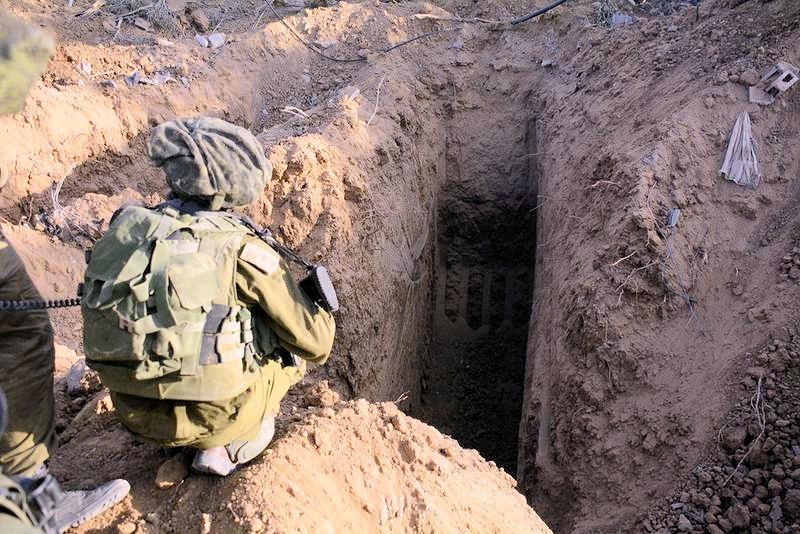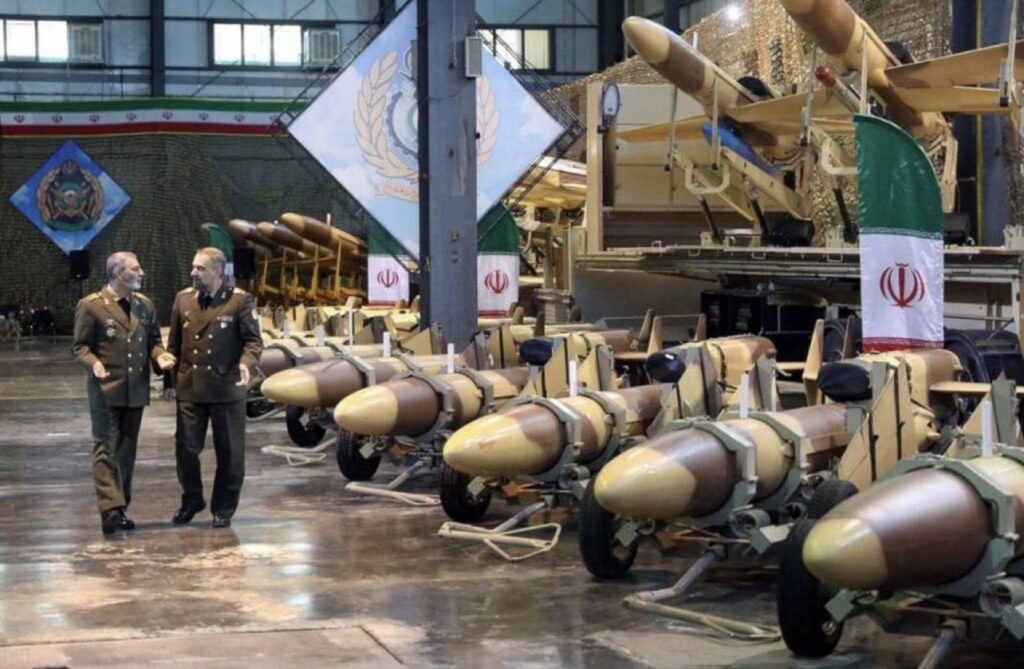UPDATES
The Tunnel Dilemma
Jul 22, 2014

Update from AIJAC
July 22, 2014
Number 07/14 #07
Tonight’s Update focuses solely on Israel’s Operation Protective Edge in the wake of Israel’s ground penetration into Gaza and, more specifically, the need to destroy the extensive Hamas tunnel network, snaking into Israel, that is at the heart of the Israeli incursion.
First, Calev Ben David of Bloomberg sets out in some detail the dangers posed by the tunnels to Israel’s civilians and military, and the difficulties Israeli forces will face in locating and destroying them. For this useful introduction to this vexed issue, CLICK HERE.
Second, Former US Attorney-General Michael Mukasey, writing in the Wall Street Journal, suggests that the current conflict actually began in earnest because, after some lower intensity rocketing and Israeli retaliation, Hamas became concerned that Israel had discovered the extent of the tunnel network, and was about to set out to destroy it. He writes that Hamas sees its tunnels as more important than its rockets, as they give it the capability of launching a wide ranging terror attack inside Israel, similar to the rampage in Mumbai, India in 2008 which killed 164. He also details why Hamas feels so isolated and vulnerable at the moment, and the steps that led it to this stage. For his interesting perspective, CLICK HERE.
Finally, Israeli security correspondent Ron Ben-Yishai of Ynet.com urges Israel to persevere with the operation, despite the casualties it is incurring, in part so that those sacrifices will not have been made in vain. He states that Operation Protective Edge was launched largely to end the menace caused by the tunnels, and if Israel shows weakness now, it will just motivate Hamas and Islamic Jihad to keep fighting. He adds that Hezbollah is also watching. To read his heartfelt plea, CLICK HERE.
Readers may also be interested in:
- Noted Legal academic Alan Dershowitz discussing his own experience of how Hamas places the entrances to the tunnels in schools, hospitals and houses, and arguing Israel has no choice but to go in on the ground and shut them down.
- Mitch Ginsburg of the Times of Israel explains the difficulty of locating and destroying the tunnels. He notes that, for example, when the tunnel entrances are in houses, the residents often cover them with a fresh coat of concrete before the troops arrive, and they are also often booby-trapped. Ginsberg also explained that finding the tunnels are Israel’s first military priority, due to the danger they pose to all Israelis living anywhere near Gaza
- Amos Harel of Ha’aretz provides some details of some of the intense ground battles fought by the Israeli forces in Gaza – especially in the Gaza neighbourhood of Shuja’iya, which is the source of the rise in casualties over recent days on both sides.
- A blog from the Israel Defence Forces sets out the rationale for the battle in Shuja’iya, and provides diagrams and photos to illustrate how the terrorists have insinuated themselves among its civilians
http://www.idfblog.com/blog/2014/07/20/shujaiya-hamas-terror-fortress-gaza/ - Some examples from the many stories and comments now appearing at AIJAC’s daily “Fresh AIR” blog:
- Gabrielle Debinski identifies some important points about Israel’s Gaza strategy made by Israeli PM Netanyahu in an interview he gave on CNN.
- Robert Ellenhorn on how many Arab commentators “get it” about the role of Hamas in the current conflict.
- Ahron Shapiro takes the ABC and SBS to task for using news reports on Israel-Gaza from al-Jazeera – owned and financed by Qatar, Hamas’ most important backer in the Arab world.
Maze of Secret Gaza Tunnels Targeted by Israel Offensive
By Calev Ben-David
Bloomberg, Jul 21, 2014
As Israeli soldiers stand guard, an excavator forces its way through the earth in an open area of the southern Gaza Strip, smashing through the concrete walls of an underground tunnel snaking its way under Israel’s border.
The military is distributing video footage about tunnels it says it’s discovered to press its case for the ground war Israel is waging in the Hamas-controlled territory. Its declared aim: to cripple the network of passages infiltrators built to burrow into Israel to kill or kidnap its citizens.
While the Iron Dome missile defense system has proven largely successful at intercepting rockets launched from Gaza at Israel’s cites and towns, no such technology has proven similarly efficient at detecting underground passageways dug under the border. Israel sent ground troops into Gaza after air strikes failed to cripple the infiltration conduits, which militants used three times this month to slip into Israel, including today.
Demolishing those tunnels, some dug 100 feet (30 meters) deep, will be no simple task, said retired Brigadier-General Gad Shamni, former commander of the Israeli army’s Gaza Division.
Locating the entrances to the tunnels will require Israeli forces to advance as much as a mile (2 kilometers) into Gaza, “up to the outskirts of the urban areas,” Shamni said in a phone briefing. “Then you have to penetrate the urban areas to protect your forces looking for these tunnels.”
Booby-Trapped Buildings
Israel has lost 18 soldiers in Gaza since the ground offensive began. The Palestinian death toll in two weeks of fighting has topped 500, Al Jazeera television reported today, citing Gaza Health Ministry figures. Sixty were killed in one battle in a Gaza City neighborhood, the ministry said.
Finding a tunnel’s access points also means searching in buildings that may have been booby-trapped. More footage released by Israel shows combat engineers entering a home where they discover a portable radio modified into a bomb, and explosives packed into the walls.
After two days in Gaza the army said it discovered at least 46 entrances to 14 subterranean passages.
“Beneath the Gaza Strip lies an underground Gaza, an offensive tunnel network that is almost entirely hidden on the surface and as elaborate as a labyrinth,” Israeli military spokesman Lieutenant-Colonel Peter Lerner said in an e-mailed statement last week.
The ground offensive, begun July 17 after nine days of air raids, was ordered a day after 13 Palestinian militants emerged from a tunnel about 250 meters (820 feet) inside Israel and headed for a kibbutz.
Air fire turned them back.
Infiltrators Killed
After the ground war began, two soldiers were killed by infiltrators who tunneled into Israel and fired a rocket-propelled grenade at army jeeps. The militants were wearing stolen Israeli army uniforms and carrying sedatives and plastic handcuffs with the aim of kidnapping soldiers, the army said in a statement.
Today, the military said it detected two militant squads who slipped into Israel through tunnels. Aircraft struck one squad, and soldiers killed 10 infiltrators from the other in a gunbattle, it said in a text message.
“Because it isn’t possible to deal with the tunnels only from the air, our soldiers are now doing so on the ground,” Israeli Prime Minister Benjamin Netanyahu said in his announcement of the Gaza incursion.
The military wing of Hamas, the militant movement that controls Gaza, accused Israel of fabricating allegations about tunnels.
Fabrication Alleged
“The occupation’s claim that it found tunnels and seized it by showing pictures is a complete lie designed to claim heroism and rehabilitate the reputation of its weak army,” the Ezzedeen al-Qassam Brigades said in an e-mailed statement. “All the occupation found were underground corridors dug into a training facility that belongs to our group near the border.” Israel, the U.S. and European Union consider Hamas a terrorist group.
Israel last entered Gaza in force for a three-week operation that began in December 2008. Israel has clashed with Gaza militants repeatedly since 2005, when it ended its 38-year occupation of the territory while restricting, along with Egypt, the movement of its people and goods by controlling border crossings.
Although Israel has given no deadline for concluding this Gaza incursion, Shamni estimates it will take the military about a week to destroy most of the tunnels. It’s unlikely they will find them all, he said.
Dozens Built
Hamas and other militant groups have built at least several dozen infiltration tunnels, all with offshoots that go in different directions, he said. Unless the entire tunnel is destroyed, “it’s relatively easy to fix,” he said.
The capture of Israeli soldier Gilad Shalit in 2006 illustrates the potentially sweeping benefits these underground passages hold for militants. Armed men sneaked into Israel through a tunnel and emerged behind his border outpost, killing two soldiers and hauling him to Gaza. Shalit was released in 2011 in a prisoner exchange that freed more than 1,000 Palestinians from Israeli jails.
While systems using electromagnetic or thermal technology are partially successful in mapping underground terrain, they can be affected by environmental factors such as ground composition and water deposits, said Dan Blumberg, a professor in the geography department at Ben-Gurion University of the Negev in Beersheba and head of the school’s Homeland Security Institute.
Operational Gaps
“The gap between our capability to do so in a laboratory or similarly accommodating circumstances, compared to doing so operationally in military combat conditions, is still very wide,” Blumberg told Israel Radio.
Israel has also had to grapple with another network of underground tunnels militants built to smuggle weapons and civilians goods into Gaza from Egypt. Egyptian security forces have destroyed most of those passages since Islamist President Mohamed Mursi was overthrown last year, seeing them as a threat to their country’s stability as well. Egypt banned Hamas activities on its soil earlier this year.
Israel’s current ground offensive in Gaza is not targeting the smuggling tunnels, military spokeswoman Lieutenant Libby Weiss said by phone.
Materials Barred
Another tactic Israel has pursued against tunnels has been to restrict the entry of construction materials into Gaza. After Israel uncovered a mile-long tunnel (1.7 kilometers) into its territory last October, built with about 500 tons of concrete and cement, it barred those materials from entering Gaza for any use except specific public projects sponsored by the international community.
That move has drawn criticism from human rights groups, which say the restrictions are crippling a Gaza economy reliant on the construction industry. It also leaves thousands of Palestinians without the means to build or repair homes, including those destroyed or damaged by Israeli military operations, they say.
“Any benefit Israel sees in restricting these building materials are vastly outweighed by the harm to the civilian infrastructure, and the massive unemployment that it’s causing in Gaza,” said Sari Bashi, founder of Gisha, a group that advocates for freedom of movement and goods for Palestinians.
Shamni says Egypt’s closing of the smuggling routes from Gaza will make it more difficult for Hamas to obtain the building materials it needs to replace destroyed tunnels. Ultimately, periodic ground incursions remain Israel’s only effective military means of stopping the tunnels, the former Gaza commander said.
“I just hope that this round” will extend the interval between such operations “as long as possible,” Shamni said.
Back to Top
————————————————————————
Tunnels Matter More Than Rockets to Hamas
The terror group wants to infiltrate Israel to grab hostages and stage attacks as in Mumbai in 2008.
By MICHAEL B. MUKASEY
Wall Street Journal, July 20, 2014
Early in the current clash between Hamas and Israel, much of the drama was in the air. The Palestinian terrorist group launched hundreds of rockets at Israel, and Israel responded by knocking down rockets in the sky with its Iron Dome defense system and by bombing the rocket-launch sites in Gaza. But the real story has been underground. Hamas’s tunnels into Israel are potentially much more dangerous than its random rocket barrages.
Israel started a ground offensive against Hamas in Gaza on Thursday, intending to destroy Hamas’s tunnel network. The challenge became obvious on Saturday when eight Palestinian fighters wearing Israeli military uniforms emerged from a tunnel 300 yards inside Israel and killed two Israeli soldiers in a firefight. One of the Palestinian fighters was killed before the others fled through the tunnel back to Gaza.
According to Yigal Carmon, who heads the Middle East Media Research Institute, his organization’s monitoring of published material and discussions with Israeli officials indicate that Hamas’s tunnels—and not the well-publicized episode of kidnapping and murder involving young Israelis and a Palestinian teenager—were the spark for the conflict.
Consider: On July 5 Israeli planes damaged a tunnel dug by Hamas that ran for several kilometers from inside the Gaza Strip. The tunnel emerged near an Israeli kibbutz named Kerem Shalom —vineyard of peace.
That Israeli strike presented Hamas with a dilemma, because the tunnel was one of scores that the group had dug at great cost. Were the Israelis specifically aware of the tunnel or had their strike been a random guess? Several members of the Hamas military leadership came to inspect the damage the following day, July 6. A later official Israeli report said that the Hamas inspectors were killed in a “work accident.” But what if the Israelis had been waiting for the follow-up and struck again?
Hamas now saw its strategic plan unraveling. The tunnel network gave it the ability to launch a coordinated attack within Israel like the 2008 Islamist rampage in Mumbai that killed 164 people. Recall that in 2011 Israel released more than 1,000 Palestinian prisoners, more than 200 of whom were under a life sentence for planning and perpetrating terror attacks. They were exchanged for one Israeli soldier, Gilad Shalit, who had been taken hostage in a cross-border raid by Hamas. Imagine the leverage that Hamas could have achieved by sneaking fighters through the tunnels and taking hostages throughout Israel; the terrorists intercepted Saturday night were carrying tranquilizers and handcuffs.
If the Israeli strike on the tunnel near the Kerem Shalom kibbutz presaged a drive to destroy the entire network—the jewel of Hamas’s war-planning—the terrorist group must have been thrown into a panic.
Because by this summer Hamas was already in desperate political straits.
For years Hamas was receiving weapons and funding from Shiite Iran and Syria, under the banner of militant resistance to Israel. But when Mohammed Morsi became president of Egypt in June 2012, Hamas abandoned its relationship with Iran and Syria and took up instead with Mr. Morsi and the Sunni Muslim Brotherhood. Hamas also took up with Turkey and Qatar, also Sunni states, describing them at one point as the saviors of Hamas. Former benefactors Syria and Iran then called Hamas traitorous for abandoning the resistance-to-Israel camp.
The Hamas romance with Mr. Morsi was especially galling to Shiite-led Iran and Syria. The Shiites are only 10% of the world’s Muslims, and neither Iran nor Syria welcomed the loss of a patron to Sunni Egypt.
The coup that removed Mr. Morsi and the Muslim Brotherhood regime in June 2013 brought a chill in Egypt’s relationship with Hamas that has kept Egypt’s border with Gaza closed, denying Hamas that route of supply.
But Iran and Syria did not rush to embrace their former beneficiary. When Hamas tried to re-ingratiate itself with Iran this May, its political bureau head, Khaled Mash’al, was denied an audience in Tehran and could only meet a minor diplomat in Qatar. On June 26 the Iranian website Tabnak posted an article titled, “Mr. Mash’al, Answer the Following Questions Before Asking for Help.” The questions included:
“How can Iran go back to trusting an organization that turned its back on the Syrian regime after it sat in Damascus for years and received all kinds of assistance?” and “How can we trust an organization that enjoyed Iranian support for years and then described Turkey and Qatar as its saviors?”
So on July 6, Hamas stood politically isolated and strategically vulnerable. It had lost the financial support of Egypt and could not get renewed support from Iran in the measure it needed. To some in the organization it appeared that Hamas had only one card to play—and on July 7 it played that card with rockets. As to the tunnels, last Thursday Israeli forces intercepted 13 armed terrorists as they emerged from a tunnel near Kibbutz Sufa in Israel.
There are other messages out there for the Palestinians instead of the violent one sent by Hamas. Writing in the London-based Arabic daily Al Hayat on July 12, Saudi intellectual Abdallah Hamid al-Din, no friend of Israel, urged Palestinians to abandon as unrealistic demands for a right of return, and to forgo as hypocritical calls to boycott Israel:
“The only way to stop Israel is peace. . . . Israel does not want peace, because it does not need it. But the Palestinians do. Therefore it is necessary to persist with efforts to impose peace. No other option exists. True resistance is resistance to illusions and false hopes, and no longer leaning on the past in building the future. Real resistance is to silently endure the handshake of your enemy so as to enable your people to learn and to live.”
Plenty of others are sending the same message today. Whether Palestinians will listen is another matter.
Back to Top
————————————————————————
Israel must grit its teeth and keep going in Gaza
Analysis: Israelis must endure the suffering and growing casualty list – or the country will be back in the same place very soon.
Ron Ben-Yishai
Ynet.com, July 20
In any war, campaign or operation there is a point at which the list of casualties grows at an alarming rate, and chilling stories emerge from the battlefield. And that moment has an immediate and resounding impact.
At that point, there is no difference between commanders and fighters, battle-hardened as they are, and civilians in the home front. The heart still skips a beat and blood still runs cold in the veins – even for those who were not directly involved in the fighting, even if those who were there did not lie about how the battle was fought.
This pain comes from a sense of loss and defeat, even if forces on the ground are achieving their aims and carrying out their mission.
But one can – and must – get past this. I experienced it in the Six-Day War and in similar situations since. What allows you to overcome this crisis is the knowledge that the human sacrifice was not in vain. Knowing that the fallen and wounded, the bereaved parents and those who are now permanently disabled have saved the lives of many others who needed protection and sacrifice of the fallen.
This is the case now. Israel launched Operation Protective Edge to end to the clear and present danger to the lives of Israelis posed by Hamas’ subterranean terrorist mechanism. This infrastructure was planned and built for one purpose only – to kill indiscriminately, kidnap hostages and bring the State of Israel to its knees (like with Gilad Shalit) and worse.
Even the threat of rocket fire is not negligible, despite the fact that Iron Dome and the precise IAF attacks have created an illusion of security. We knew there was a threat, but there was a sense that our lives were not really in danger if we only rushed to our protected spaces.
This was a virtual war, and we thought that the worst thing that could happen to us would be to run out of Iron Dome batteries or targets for the Air Force. This is not the case. The rocket threat from Hamas is real, and if goes on much longer there will also be more casualties – it is a question of statistics. And equally important – Hezbollah leader Hassan Nasrallah is watching from the sidelines and taking notes.
We saw the results of the attacks on Gaza, and winced at the sight of destruction and dead children, but the ground operation rubbed in our faces all the ugliness and pain and made it personal for us.
There is no doubt that the events of Saturday night in the Gaza Strip will be presented by Hamas – and one has to admit, quite rightly so – as a victory of minds and media. The organization and its leaders will try to leverage this macabre achievement in the diplomatic negotiations that have not yet begun. But we cannot play into the hands of the terrorists who have so far in this operation failed in every attempt to harm us.
In the meantime, in these difficult days of war, the rumor-mongers on the social networks and on Whatsapp must behave responsibly and show some restraint. The wild rumors are unfair to those families whose sons are now fighting in Gaza. It’s time to break this habit.
The Israeli public cannot crumble, and the media cannot give off distress signals, not because it is neither pretty nor dignified to cry and show pain, but because any signs of distress or public pressure on the government to withdraw the troops will only increase Hamas and Islamic Jihad’s motivation to keep fighting – and harden their stance during ceasefire negotiations.
This would lead to drawn-out negotiations, prolonged fighting and a higher casualty rate on both sides.
Even worse, we would be back here in a year or two, facing the same dilemmas and the same pain. So we have to grit our teeth, and keep blowing up every last tunnel and shaft we can find, until we can reach a durable, long-term ceasefire that the State of Israel and the Israeli government can live with.
Tags: Israel











